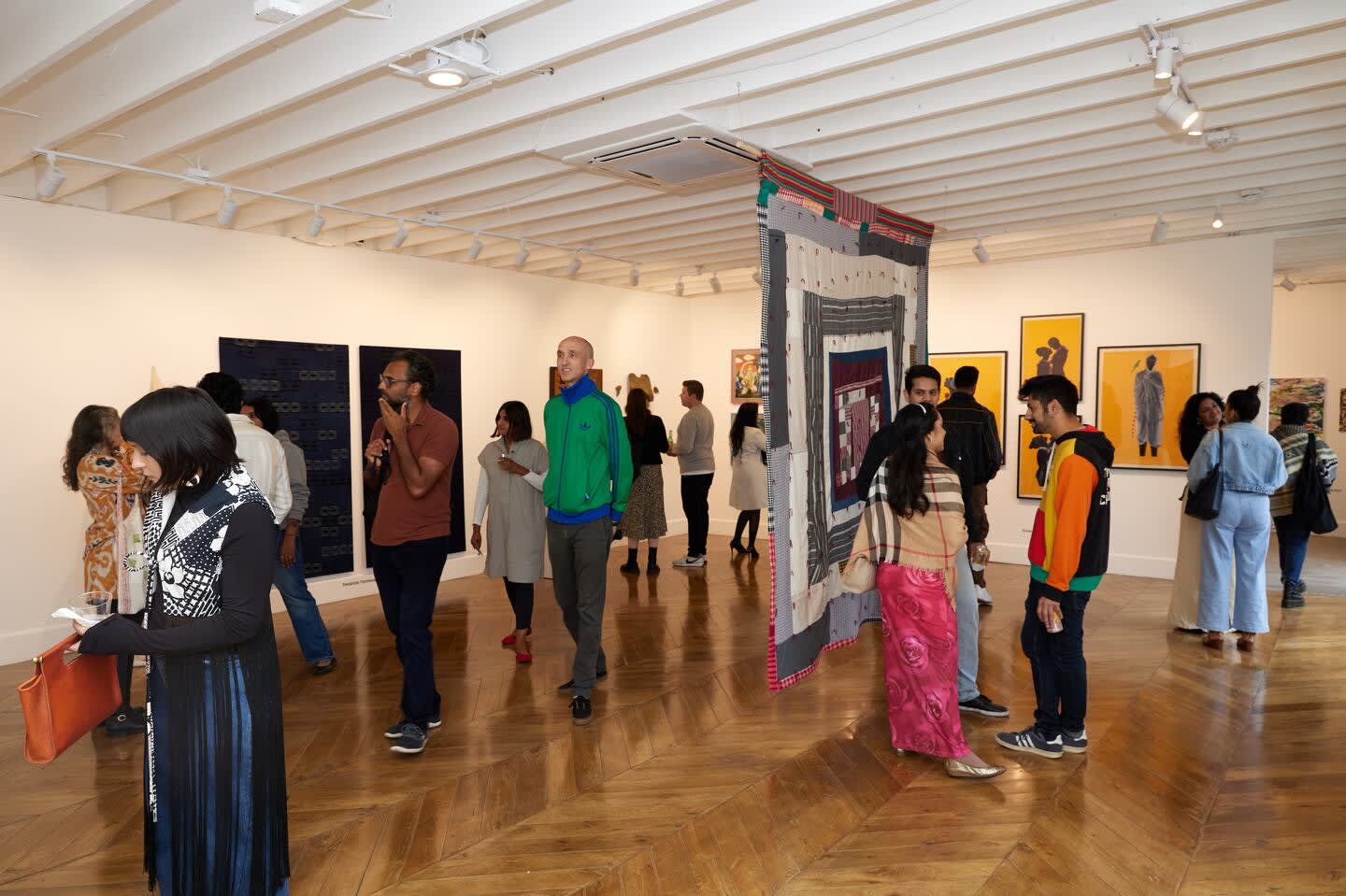Rajiv Menon Contemporary is nestled against the dusk-lit hills of Silverlake on Sunset Boulevard. As the opening night of the exhibition began on May 14, guests were greeted by a vivid display of colorful works drawing eyes in every direction.

Upon entrance, visitors were greeted by an oil painting titled “Never the Same River Twice” by Sri Lankan American artist Shyama Golden depicting a woman cradling a blue-hued mask like a child, an ode to the culture’s decorative symbol for peace and harmony. To the right of this work was an oil painting titled “Vertigo”, featuring a South Asian uncle on the phone, dressed in a beanie and sarong. The piece by Lahore-based artist Asad Ali Qulandar juxtaposed beautifully with Golden’s, sparking curiosity and bringing a smile to guests’ faces.

As the rush of guests turned the corner into the gallery’s main room, curiosity becomes conversation and the narratives further unfold.
“The Past is a Country: Indo-Nostalgia in Contemporary Art” is an intergenerational exhibition showcasing artists from South Asia and the diaspora. Since opening in November 2023, this marks the gallery’s third exhibition. What makes this gallery unique is its dedication to South Asian and diasporic art, being one of the few in the U.S. and the only gallery on the West Coast with such a focus.
Curated by Rajiv Menon, the exhibition explores the assorted meanings of “South Asianness” and its connection to memory amidst the diaspora’s encounters with political upheaval, climate change, and migration patterns.

Held during Asian American and Pacific Islander Heritage Month, the exhibition highlights the cultural significance and contributions of the South Asian community, candidly showcasing artists with personal and political stakes.
“The idea of ‘Indo-Nostalgia’ arose to give my audience a specific vocabulary to identify a very present aesthetic theme in South Asian culture,” said Menon. “My goal is that someone can leave the show and point to other examples of Indo-Nostalgia, not just in visual art, but in fashion, food, music, dance, and beyond.”

Featuring work from nineteen artists, many making their U.S. debut, the exhibition spans an array of mediums and scales. The roster includes Mohd. Intiyaz, Vikrant Bhise, Soumya Sankar Bose, Bhasha Chakrabarti, Misha Japanwala, Sivasubramaniam Kajendran, Shyama Golden, Firi Rahman, Shradha Kochhar, Utkarsh Makwana, Hamid Ali Hanbhi, Asad Ali Qulandar, Swapnaa Tamhane, Mussarat Arif, Russna Kaur, Anoushka Mirchandani, Manjari Sharma, Noormah Jamal, and Sanié Bokhari.
The overall dialogue of work contextualizes Indo-Nostalgia from an array of perspectives across the region they derive from. Manjari Sharma’s photography reinterprets Hindu iconography found in Indian calendar art, reflecting the increased distribution of Hindu imagery in India.
Bhasha Chakrabarti’s paintings and quilt work reference the history of quilt-making as feminine labor and a form of resistance in West Bengal, Hawaii, and Alabama.

Sivasubramaniam Kajendran, making his U.S. debut, uses Catholic iconography to address loss in Sri Lanka, particularly the civil war and the 2004 tsunami.
During the opening, there was a strong reaction to many works’ themes of socio-political oppression through caste systems, a depiction that garnered a lot of attention from attendees, especially in Vikrant Bhise’s painting “Dalit Panther, Worli Riots.”

In a walkthrough of the exhibition, Menon pointed out that the Dalit Panther’s name was inspired by the Black Panther Party and that the painting style was influenced by Diego Rivera.
Bhise’s paintings, also making their U.S. debut, examined casteism and political revolutions through the writings of B.R. Ambedkar.
At the forefront of the struggle against caste-based domination and its vertiginous implications on land, liberty, and labor, Bhise showed commitment to realizing enduring reform through activism and remembering struggles against caste, class, and gender-based oppression.
Other artists went beyond traditional art and provided a unique perspective through mixed media.
Sanié Bokhari and Her Piece, “Malika”
Sanié Bokhari, an artist born in Lahore, Pakistan, brought a unique perspective to the exhibition. Her artwork, “Malika,” is a standout, drawing upon the intricate history and culture of the subcontinent. Bokhari earned her BFA from the National College of Arts in Lahore and her MFA in Painting from the Rhode Island School of Design (RISD), where she was awarded the President’s Scholarship.
“Malika” serves as a fusion of the past and present, depicted through a metaphorical carpet that weaves its roots while the protagonist takes flight.

“The carpet assumed different forms in the minds of each observer at the show—some perceive it as a magic flying carpet, while others interpret it as a prayer rug,” Bokhari shared. “Both interpretations empower the character, transcending age-old tropes and casting eyes towards the future.”
This symbolism is enhanced by laser beams emanating from the character’s eyes, representing an embrace of change and technology.

The presence of South Asian artists in Los Angeles brings a rich dialogue to the city’s cultural landscape, and the location for the gallery was designated with intention.
Menon chose L.A. for his gallery over cities like New York or London because it was essential for the visual arts to be in dialogue with the larger movement around South Asian representation in media.
“Hollywood is the epicenter of the conversation about global South Asian visibility, but I found that without the visual arts, this conversation felt incomplete,” said Menon. ”By engaging with larger questions of aesthetics, not just the visibility of South Asian people, we can have a much deeper conversation about representation. The South Asian community in the entertainment industry has been incredibly supportive and engaged with the gallery, which makes me want to invest even more in building out the gallery in L.A.”
“The Past is a Country: Indo-Nostalgia in Contemporary Art” runs through June 3 at Rajiv Menon Contemporary.



